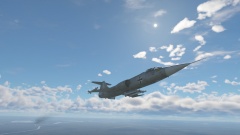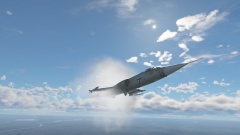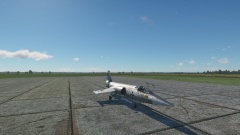Difference between revisions of "AIM-9B FGW.2 Sidewinder"
(Updated page to give more information on this missile itself instead of just copying some info from the AIM-9B. Added images, history, and usage on the F-104G.) (Tag: Visual edit) |
Inceptor57 (talk | contribs) (Readded section description as comments,) |
||
| Line 1: | Line 1: | ||
== Description == | == Description == | ||
| + | <!--''Write an introduction to the article in 2-3 small paragraphs. Briefly tell us about the history of the development and combat using the weaponry and also about its features. Compile a list of air, ground, or naval vehicles that feature this weapon system in the game.''--> | ||
The AIM-9B FGW.2 Sidewinder is an [[Air-to-air missiles#Infrared homing .28heat-seeking.29 missiles|infrared homing air-to-air missile]], introduced in [[Update "Starfighters"|Update 1.99]] "Starfighters." Found only on the German [[F-104G]], it exists as an exact copy of the [[AIM-9B Sidewinder]], despite being an upgraded AIM-9B that resembled the [[AIM-9E Sidewinder|AIM-9E]] more closely. Thanks to being exactly identical to the AIM-9B, it performs exactly the same and thus should be used the same way. | The AIM-9B FGW.2 Sidewinder is an [[Air-to-air missiles#Infrared homing .28heat-seeking.29 missiles|infrared homing air-to-air missile]], introduced in [[Update "Starfighters"|Update 1.99]] "Starfighters." Found only on the German [[F-104G]], it exists as an exact copy of the [[AIM-9B Sidewinder]], despite being an upgraded AIM-9B that resembled the [[AIM-9E Sidewinder|AIM-9E]] more closely. Thanks to being exactly identical to the AIM-9B, it performs exactly the same and thus should be used the same way. | ||
| Line 8: | Line 9: | ||
== General info == | == General info == | ||
| + | <!--''Tell us about the tactical and technical characteristics of the missile.''--> | ||
Until the missile is updated to resemble it's real-life counterpart, the FGW.2 will be the same as the 9B. The missile's performance is generally sub-par in comparison to other missiles found around 9.0 to 10.7, thanks to the FGW.2 basing it's stats of a missile designed in 1954-6. With only 10G's of overload and a tracking rate of 11°/s, it performs terribly in high-G dogfights. 4 seconds of warm-up time also limits it's effectiveness, so don't expect to be throwing these around. Thankfully the only platform that gets this variant is the F-104G, so dogfighting is not advised. | Until the missile is updated to resemble it's real-life counterpart, the FGW.2 will be the same as the 9B. The missile's performance is generally sub-par in comparison to other missiles found around 9.0 to 10.7, thanks to the FGW.2 basing it's stats of a missile designed in 1954-6. With only 10G's of overload and a tracking rate of 11°/s, it performs terribly in high-G dogfights. 4 seconds of warm-up time also limits it's effectiveness, so don't expect to be throwing these around. Thankfully the only platform that gets this variant is the F-104G, so dogfighting is not advised. | ||
| Line 13: | Line 15: | ||
=== Effective damage === | === Effective damage === | ||
| + | <!--''Describe the type of damage produced by this type of missile (high explosive, splash damage, etc)''--> | ||
| + | |||
For being relatively bad to other missiles, the FGW.2 does not disappoint in the damage department. Like every other AAM, if this missile connects, it will 1-shot or at least deal critical damage to any aircraft. Obviously, it can't be used against ground targets, unless you count parked and active aircraft. | For being relatively bad to other missiles, the FGW.2 does not disappoint in the damage department. Like every other AAM, if this missile connects, it will 1-shot or at least deal critical damage to any aircraft. Obviously, it can't be used against ground targets, unless you count parked and active aircraft. | ||
=== Comparison with analogues === | === Comparison with analogues === | ||
| + | <!--''Give a comparative description of missiles that have firepower equal to this weapon.''--> | ||
It's performance is identical to the [[AIM-9B Sidewinder|AIM-9B]] and [[R-3S|R-3]] missiles, but is massively outperformed by mid-tier missiles like the [[AIM-9D Sidewinder|AIM-9D]], [[AIM-9E Sidewinder|E]], [[R-60]], and [[Matra R550 Magic 1|R550]]. It's lack of a moveable seeker-head, higher G-pulling, range, and sensitivity make it subpar if not for having 4 on a platform that is capable of traveling at Mach 2. | It's performance is identical to the [[AIM-9B Sidewinder|AIM-9B]] and [[R-3S|R-3]] missiles, but is massively outperformed by mid-tier missiles like the [[AIM-9D Sidewinder|AIM-9D]], [[AIM-9E Sidewinder|E]], [[R-60]], and [[Matra R550 Magic 1|R550]]. It's lack of a moveable seeker-head, higher G-pulling, range, and sensitivity make it subpar if not for having 4 on a platform that is capable of traveling at Mach 2. | ||
== Usage in battles == | == Usage in battles == | ||
| + | <!--''Describe situations when you would utilise this missile in-game (vehicle, pillbox, base, etc)''--> | ||
| + | |||
This missile's best usage comes in 3 situations, low energy, roll-rate spamming and compressed enemies. | This missile's best usage comes in 3 situations, low energy, roll-rate spamming and compressed enemies. | ||
| Line 30: | Line 37: | ||
=== Pros and cons === | === Pros and cons === | ||
| + | <!--''Summarise and briefly evaluate the weaponry in terms of its characteristics and combat effectiveness. Mark pros and cons as a list.''--> | ||
| + | |||
'''Pros:''' | '''Pros:''' | ||
| Line 71: | Line 80: | ||
== Media == | == Media == | ||
| + | <!--''Excellent additions to the article would be video guides, screenshots from the game, and photos.''--> | ||
<gallery> | <gallery> | ||
File:AIM-9B FGW.2 Image 1.jpg|F-104G mid-flight with 3 AIM-9B FGW.2 Sidewinders (1 Fired) | File:AIM-9B FGW.2 Image 1.jpg|F-104G mid-flight with 3 AIM-9B FGW.2 Sidewinders (1 Fired) | ||
| Line 78: | Line 88: | ||
== See also == | == See also == | ||
| − | + | <!--''Links to the articles on the War Thunder Wiki that you think will be useful for the reader, for example:'' | |
| + | * ''reference to the article about the variant of the weapon;'' | ||
| + | * ''references to approximate analogues by other nations and research trees.''--> | ||
* [[AIM-9B Sidewinder|AIM-9B]] | * [[AIM-9B Sidewinder|AIM-9B]] | ||
* [[AIM-9E Sidewinder|AIM-9E]] | * [[AIM-9E Sidewinder|AIM-9E]] | ||
Revision as of 07:31, 29 December 2020
Contents
Description
The AIM-9B FGW.2 Sidewinder is an infrared homing air-to-air missile, introduced in Update 1.99 "Starfighters." Found only on the German F-104G, it exists as an exact copy of the AIM-9B Sidewinder, despite being an upgraded AIM-9B that resembled the AIM-9E more closely. Thanks to being exactly identical to the AIM-9B, it performs exactly the same and thus should be used the same way.
Vehicles equipped with this weapon
General info
Until the missile is updated to resemble it's real-life counterpart, the FGW.2 will be the same as the 9B. The missile's performance is generally sub-par in comparison to other missiles found around 9.0 to 10.7, thanks to the FGW.2 basing it's stats of a missile designed in 1954-6. With only 10G's of overload and a tracking rate of 11°/s, it performs terribly in high-G dogfights. 4 seconds of warm-up time also limits it's effectiveness, so don't expect to be throwing these around. Thankfully the only platform that gets this variant is the F-104G, so dogfighting is not advised.
The AIM-9B FGW.2 is known also as the AIM-9F, an upgrade to the AIM-9B that resembled an upgraded AIM-9E. Little is known on the specifics of the F variant, other than the sensor window being changed to green, upgraded tech to solid state electronics instead of vacuum tubes, and a new cooling system. This lack of exact information and a designation so similar to the AIM-9B is probably why Gaijin hasn't updated the missile to it's historical state.
Effective damage
For being relatively bad to other missiles, the FGW.2 does not disappoint in the damage department. Like every other AAM, if this missile connects, it will 1-shot or at least deal critical damage to any aircraft. Obviously, it can't be used against ground targets, unless you count parked and active aircraft.
Comparison with analogues
It's performance is identical to the AIM-9B and R-3 missiles, but is massively outperformed by mid-tier missiles like the AIM-9D, E, R-60, and R550. It's lack of a moveable seeker-head, higher G-pulling, range, and sensitivity make it subpar if not for having 4 on a platform that is capable of traveling at Mach 2.
Usage in battles
This missile's best usage comes in 3 situations, low energy, roll-rate spamming and compressed enemies.
Enemies at low energy can't dodge this missile, as their planes won't be able to maneuver above 10Gs.
Enemies that constantly roll in order to dodge your guns will find the missile to be much more accurate, as their aileron rolls put them in a situation where they can't run.
Enemies that have hit compression speeds will find your missiles hard to dodge as well. The French Vautour bombers, high speed MiG-15's, and F11F-1's won't be able to outturn the missile's seeker at high speeds, and will be forced to either die or bleed enough speed to maneuver. It has a top speed of around 1.7 Mach, so the people who can outrun this missile with low maneuverability is other F-104's.
Forcing enemies to bleed speed is more of this missile's job, but speed isn't a big deal for the F-104, so it's kind of redundant.
Pros and cons
Pros:
- Effective against low-energy targets
- Decent at longer ranges in a straight line
- Effective against aircraft with low maneuverability
- Effective against aircraft in their high-speed compression ranges
- Only available on a platform that benefits from it's more passive role
Cons:
- Small seeker area
- Short range relative to other AAMs
- Poor maneuverability limits it's capability in top-tier dogfights
- Only available on 1 aircraft
- Statistics and models are inaccurate
History
Development
The missile’s history starts at the Naval Ordnance Test Station (NOTS) at China Lake in 1947.[1] Under William B. McLean, the missile conception sprang from mating lead-sulfide proximity fuzes that were sensitive to infrared radiation with a guidance system to home onto the infrared source.[2] Initially his own private project, McLean eventually received approval by Admiral William S. Parsons for development.[1]These missiles were first test fired in 1951, with the first air-to-air hit was made on 11 September 1953 on a drone.[3] This experimental missile would be designated as the XAAM-N-7. The missile would also earn the name "Sidewinder" by the development team, named after the desert rattlesnake that senses its prey’s heat and moves in a winding motion.[1][2]
Initially a US Navy project, the US Air Force was urged into participating by Howard Wilcox, the next project lead after McLean was promoted to upper management at NOTS in 1954.[1] This culminated in a shoot-off in June 1955 between the Navy’s Sidewinder against the Air Force’s GAR-2 Falcon missile. The Sidewinder’s performance in this event resulted in the US Air Force putting their support in the Sidewinder.[3] By May 1956, the missile was officially adopted as the AAM-N-7 for the US Navy and the GAR-8 for the US Air Force.[3][4] These designation would remain until 27 June 1963, when the Sidewinder’s designations were standardised across all armed services as the AIM-9.[5]
AIM-9B FGW.2
The AIM-9B (pre-1963 Navy designation AAM-N-7 Sidewinder IA) was the initial production version of the Sidewinder.[3] More than 80,000 units of the AIM-9B Sidewinder would be produced.[4]
The Sidewinder was also acquired by NATO forces for their air forces. The AIM-9B licensed production was distributed to West Germany, who would produce 15,000 units.[4] Like the US Navy and US Air Force, the manufacturer sought to improve the AIM-9B design. These improvements modernized the components with solid-state technology, added a carbon dioxide cooling for the seeker, developed a new nose dome and implemented better optical filtering.[6] The culminations of these improvements developed into the AIM-9B FGW.2, which is also known as the AIM-9F in US nomenclature.[3] These missiles would see service in 1969, with conversions being done on European AIM-9B with the FGW.2 upgrade.[4][3]
The AIM-9E was developed at the behest of the US Air Force (USAF), making it the first Sidewinder variant created expressly for that service (the previous Sidewinders were all developed for the US Navy). Similarly, the AIM-9F was developed and produced in Germany, making it the first Sidewinder variant developed by a foreign country. The AIM-9F was produced by BGT (Bodensee Gerätetechnik), predominately for sale to NATO air arms. Both the -E and -F models were developed from the more common AIM-9B.
The AIM-9F is identical in shape to the AIM-9B, and seems to differ only in a slightly greenish sensor window. See the AIM-9 page for a detailed description of the AIM-9B for comparison.
The general composition of the AIM-9F Sidewinder is largely the same as those of previous missiles, though several components of this new model were different. The AIM-9F followed a different design philosophy from the AIM-9E, with a new version of the AIM-9B's seeker window (which has the aforementioned characteristic green color), a carbon dioxide cooling system, and solid state electronics.
The AIM-9F, as well as all four of the second generation Sidewinders (E, F, G and H models) are infrared-guided, but their guidance was markedly improved over the first generation. It is unclear as to what changes were made with the AIM-9F's guidance system, though they reportedly resulted in an improved pK ratio. All four models still use the lead sulfide seeker element of the preceding Sidewinders.
Media
See also
External links
- References
- Bibliography
- “AIM-9F Sidewinder.” Military Today, www.military-today.com/missiles/aim_9f_sidewinder.htm.
- Gervasi, Tom. America's War Machine: the Pursuit of Global Dominance: Arsenal of Democracy III. Grove Press, Inc., 1984.
- Goebel, Greg. "The Falcon & Sidewinder Air-To-Air Missiles." Air Vectors, 01 Apr. 2019, Website.
- Hollway, Don. "The AIM-9 Sidewinder: Fox Two!" HistoryNet, Website.
- Kopp, Carlo. "The Sidewinder Story: The Evolution of the AIM-9 Missile." Air Power Australia, 27 Jan 2014, Website.
- Parsch, Andreas. "AIM-9." Directory of U.S. Military Rockets and Missiles, Designation-Systems.Net, 09 July 2008, Website.
- Parsch, Andreas. "Current Designations of U.S. Unmanned Military Aerospace Vehicles." U.S. Military Aviation Designation Systems, Designation-Systems.Net, 30 March 2020, Website.






